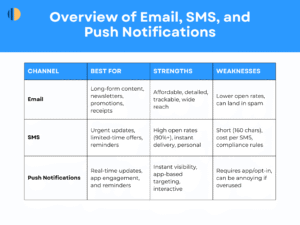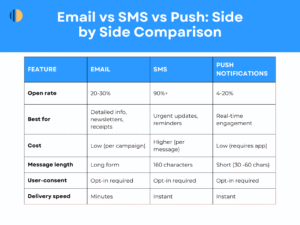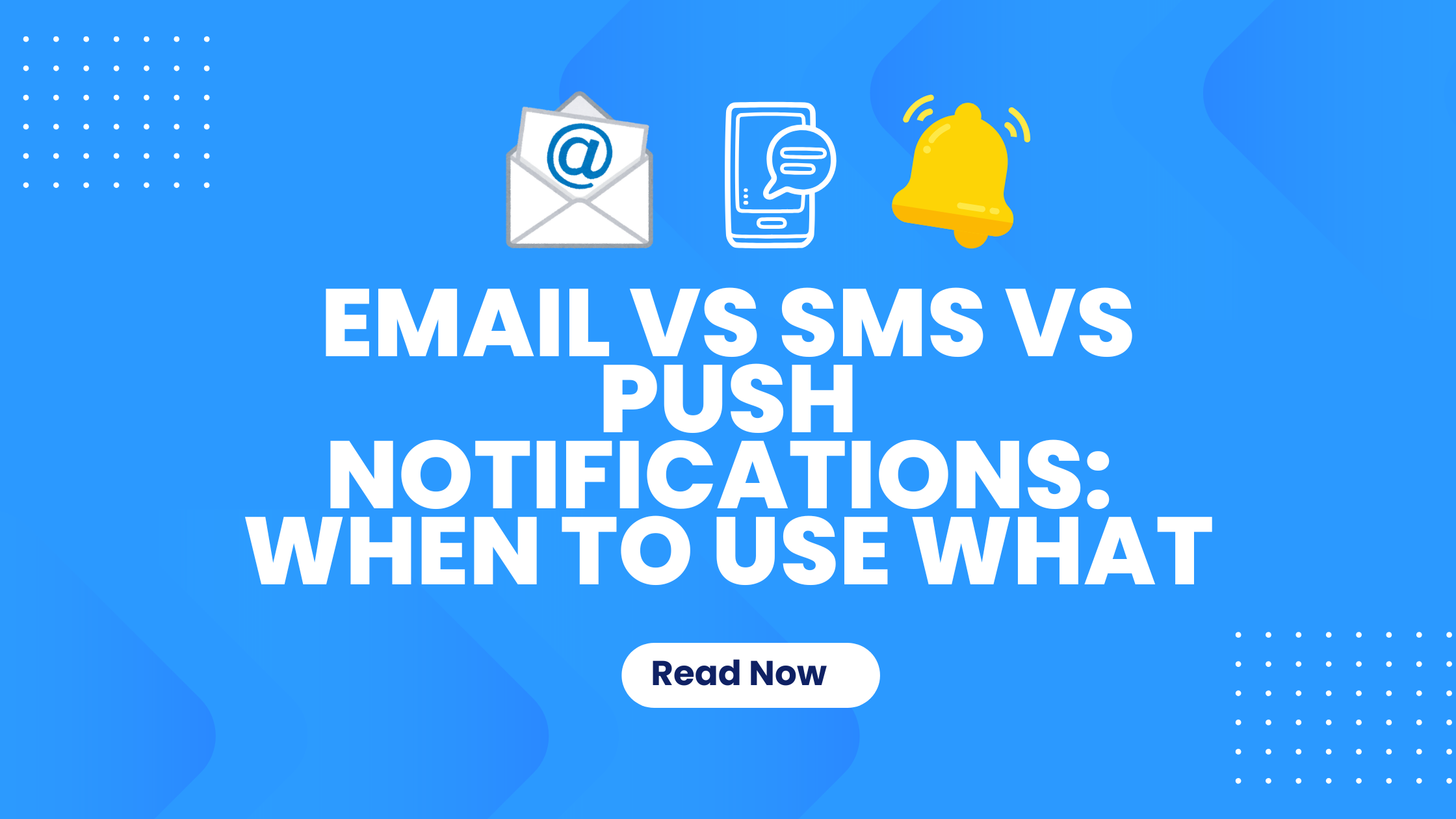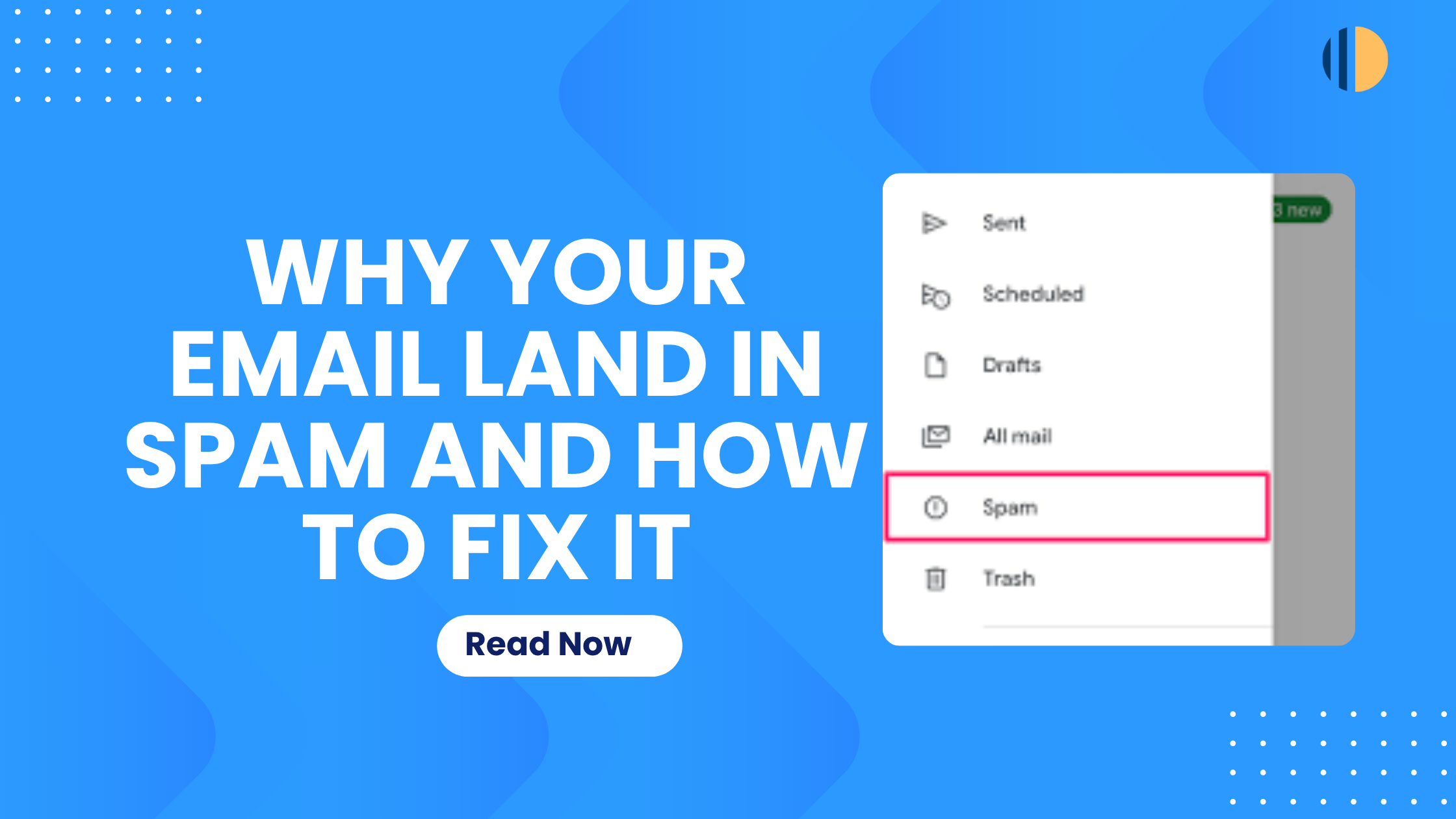Every day, you and I receive dozens of messages: emails, text messages, and those little pop-ups on our phones called push notifications. We ignore some and read others immediately.
As a brand or marketer, you face the same challenge: Which channel should I use to reach my audience?
Should I send an email when launching a new product?
Should I use SMS for a flash sale?
Or would a push notification do the job better?
That’s exactly what we’ll break down today: When to use what; email vs SMS vs Push
By the end of this blog post, you’ll understand how to choose the right channel for the right moment.
First, let’s look at Email, SMS, and Push at a Glance
Here is a summary:

When to Use Email
Email is a means of communication that uses an electronic device to deliver messages, and it’s still incredibly effective to this day.
You should use email when you need to:
- Share detailed information (product launches, newsletters, guides)
- Send transactional updates like receipts, confirmations, or invoices.
- Nurture leads through automated email sequences.
- Run cost-effective, scalable marketing campaigns.
Example:
A digital bank sends an email with the subject line:
“Your August statement is ready”
Inside this email, the customer sees their transactions, spending summary, and tips to save money.
If you’re sending an email as a FinTech brand, include visuals like pie charts. They make complex financial data easier to digest.
When to Use SMS
SMS stands for Short Message Service. It is a service for sending and receiving short text messages between mobile devices.
You can send and receive SMS messages on different mobile networks, and they usually can’t be longer than 160 characters.
SMS is brief, straightforward, and nearly always read in a matter of minutes.
You should use SMS when you need to:
- Send time-sensitive alerts (flash sales, delivery updates).
- Remind customers about appointments or events.
- Share exclusive discount codes.
- Deliver two-factor authentication (2FA) or OTPs.
Example:
A customer receives an SMS with the message:
“ALERT: Your account balance is below ₦5,000. Please top up to avoid failed payments.”
What do you think would be the customer’s next action? To top up, right? Exactly.
When writing SMS, keep it clear, short, and free of unnecessary words. Customers need speed and clarity when money is involved.
When to Use Push Notifications
Push notifications are those short messages that pop up on your phone or desktop. They are designed to grab attention instantly with updates, reminders, or offers.
You should use push notifications when you need to:
- Drive users back into your app or website.
- Send real-time reminders (cart abandonment, order shipped).
- Share breaking news or trending updates.
- Nudge users with personalized offers.
Example:
A fintech app sends a push notification at 9 AM, and it reads:
“Hi Tola, your electricity bill of ₦12,000 is due today. Pay now with one tap.”
Such a pop-up notification would instantly cause Tola to take action.
When sending push notifications, use timing wisely. Sending bill reminders in the morning is better than late-night nudges.
Email vs SMS vs Push: Side-by-Side Comparison
Here’s a direct comparison of the three channels:

Frequently Asked Questions (FAQs)
1. Is SMS better than email for promotions?
It depends. If it’s urgent, like a 24-hour sale, SMS is better. For regular promotions with more details, email works best.
2. Are push notifications better than SMS?
Push notifications are great for app engagement, but SMS works better if you want guaranteed reach (since not everyone has your app installed).
3. Do push notifications work without an app?
On mobile, no, they require an app. On the web, yes, if the user opts into browser notifications.
4. Can SMS replace email?
No. SMS is too short for detailed communication. Email still dominates for receipts, invoices, newsletters, and longer campaigns.
5. How many push notifications are too many?
If you’re sending more than 2–3 push notifications a day, users might mute or uninstall your app. Balance is key.
Which Channel Should You Choose?
Here’s a quick framework to help you decide:
Is it urgent? → Use SMS or push.
Do you need details or visuals? → Use email.
Do you want app engagement? → Use push.
Do you want long-term nurture? → Use email.
Do you need immediate action? → Use SMS.
Finally,
Email, SMS, and push notifications are not enemies; they’re teammates.
Email is your best friend for long-form, nurturing communication.
SMS is your secret weapon for urgency and instant attention.
Push notifications are perfect for quick nudges and app engagement.
The real magic happens when you combine them in a smart, customer-first strategy.
So next time you’re planning a campaign, ask yourself: What do I want my customer to do, and which channel will get them there fastest?
What did you learn from this blog post? Drop a comment about it.




